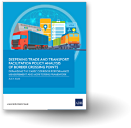Beggaring-thy-neighbour in the Asia Pacific
Resort to protectionism has a particular significance to developing countries in the Asia Pacific region given their attachment to export-led growth strategies.
The temptation to shift the pain of adjustment on to trading partners inevitably rises during sharp growth downturns, like the one witnessed when the global economic crisis hit. Slower growth in key overseas markets, notably in North America and Western Europe, reinforce pressures for an us-versus-them commercial policy.
This note summarises the latest evidence on the harm done to and by members of the ADB since November 2008, the month when many nations started pledging not to engage in protectionism.
Several organisations monitor protectionism. The most comprehensive monitoring is undertaken by the Global Trade Alert (GTA), an independent initiative which I coordinate. The GTA takes a 21st century approach to protectionism, taking account of the many disparate ways in which governments can favour domestic firms, workers, investors, and owners of intellectual property over foreign rivals.
In contrast, WTO reports focus on “trade restrictive” measures and the World Bank has put the spotlight on protection against dumped and subsidised imports and import surges. As will become clear, a focus on such traditional protectionism would miss many of the ways in which the commercial interests of developing country ADB members have been harmed in recent years.
The GTA database was last substantially updated in late May 2014 and now includes over 5,000 reports on government measures taken since November 2008.
While policymakers openly fretted most about protectionism in 2009, Figure 1 shows that the number of times ADB developing member countries were harmed by foreign protectionism was greater in 2013. Both within the Asia Pacific region and worldwide, beggaring-thy-neighbour made a quiet but pronounced return in 2013 (and in 2012 for that matter.) Reporting lags make it too soon to say for sure if 2014 is as bad. Any notion that protectionism was a temporary blip at the start of the crisis should be set aside—there is no room for complacency in defending national commercial interests against foreign protectionism.
Figure 1. ADB members are hit more often by protectionism than they harm others.

It is noteworthy that crisis-era protectionism—including the uptick in 2012 and 2013—has occurred despite WTO rules and the signing of many regional trade agreements, both within and outside the Asia Pacific.
Of course, the resort to protectionism could have been greater in the absence of these accords, however that point has yet to be demonstrated. After all, like many other WTO members, numerous governments in the Asia Pacific region could have increased their tariffs by more than the infamous Smoot Hawley tariff hike without violating their multilateral trade obligations.
In the light of these institutional realities, perhaps it would be better to ask how WTO rules could ever have restrained much protectionism, rather than whether those rules “worked”?
Since November 2008, ADB developing member countries have implemented 1010 measures that harm foreign commercial interests as well as 401 measures that liberalise or improve the transparency of the national policies. Over the same time frame, these countries’ commercial interests have been harmed 1971 times by foreign protectionism and have benefited from 661 liberalising and transparency-improving measures abroad. Over half of the hits to their commercial interests come in the form of tariff increases and so-called trade defence measures. These totals imply that almost every day a policy is implemented somewhere in the world that harms ADB developing country interests.
One interesting difference between ADB developing member countries and the rest of the world is in the choice of protectionist policy, see Figure 2. Traditional import restrictions—tariffs and trade defence measures—account for half of protectionist measures taken by ADB developing member countries, whereas only 30% of the rest of the world’s protectionism takes this form.
Figure 2. ADB developing member countries use a more traditional mix of protectionism than others.

ADB developing member countries are more likely to resort to local content requirements and to export taxes and restrictions, whereas other countries resort to competition-distorting subsidies and bailouts more often.
Less is known about the impact of these non-tariff measures and clearly more analysis is needed here. A better understanding of the rationale for differential policy choices is needed as well.
Given the weak or non-existent disciplines in many trade agreements—both multilateral and regional--on forms of beggar-thy-neighbour activity commonly in use today, the empirical base now available to analysts and policymakers could start a process of study and reflection that ultimately provides the foundation for a new generation of trade accords.
*Simon J. Evenett is Professor of International Trade and Economic Development, University of St. Gallen, Switzerland and is coordinator of Global Trade Alert, an independent monitor of commercial policy developments




